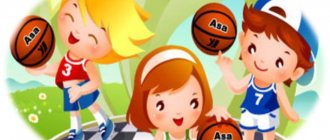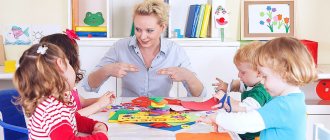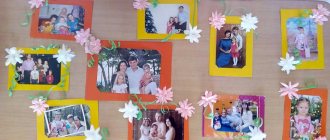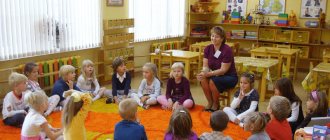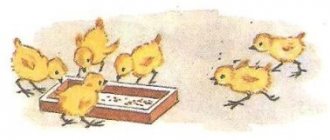Summary of the conversation on the topic: Healthy lifestyle in the senior group of kindergarten
Conversation “Viruses and pests”.
Senior group Form of conduct: Conversation Purpose: To improve children's knowledge about human illness, about what causes the disease. Clarify ideas about how to avoid viruses from entering the human body. Objectives: - To instill in children a desire to lead a healthy lifestyle.
Form ideas about what is healthy and unhealthy. Deepen knowledge about the rules of personal hygiene - Develop conversational speech, children's memory, expand vocabulary. Progress of the conversation
If the frost aches your bones, it means the flu is coming to visit you.
So that your enemy turns off the path, Take - ... (Vitamins, ascorbic acid.) If your throat hurts, your voice has subsided to zero, So that you can sing as before, It will give you strength ... (Aerosol.) If a runny nose bothers you, a damp napkin becomes, The doctor will tell you What will the drops and... (Pipette) help you with? So that the disease does not knock you off your feet, eat onions, and evil garlic, And lemons, oranges - All edible vitamins. To say “No!” to diseases, increase... (Immunity) If the virus goes everywhere, Like a villain from an ancient fairy tale, I won’t be shy here, But I’ll put it on instantly... (Bandage) Educator: I think you guessed that today the topic of our conversation is: Viruses and microbes. Your health is more valuable than anything in the world, and viruses are trying to ruin it! Tell me, guys, which of you was sick this year? (Children's answers) Educator: Tell us, by what signs can we understand that a person is sick? Sample answers from children: (fatigue, cough, sneezing, runny nose, headache, bad mood, weakness). Physical exercise “All the guys stood up together” All the guys stood up together and walked in place. They stretched on their toes, and now they bent back. Like springs, we sat down and quietly sat down at once. Educator: Why do people get sick? (Children's answers) Educator: That's right, because the virus enters the body. Does anyone know what a virus is? Educator: A virus is something between living and inanimate nature. It is so tiny that we cannot see it and cannot exist on its own. And in order to survive, it penetrates the cells of the body. Then it multiplies and penetrates other cells. As it increases, it leads to the development of the disease. What should you do to get sick as little as possible? (Children's answers) Educator: What hygiene rules do you know? (Sample answers from children: Wash your hands with soap. Wash vegetables and fruits. Brush your teeth 2 times a day. Use only your own handkerchief, comb, toothbrush, towel). Let's play a game and see if you know which hygiene items can be used together and which only one can use. Game “guess without words” Using a counting rhyme, the driver is selected and leaves the group. The teacher and the children agree on who will portray what and what. Then the driver is invited, the children take turns demonstrating hygiene skills using gestures and facial expressions. The presenter must guess what the children are showing: washing, brushing teeth, wiping, combing their hair, bathing. Educator: We told you what you need to do to avoid getting sick. What if we are already sick? (children's answers) Educator: Well done, we need treatment, and how to get treatment correctly? What should you do for this? (children’s response) Well done guys, I think we’re not afraid of colds now. Let's repeat the rules that will help us not get sick: Do not drink raw water. Do not eat unwashed fruits and vegetables. Don't forget to wash your hands with soap often. Temper yourself. Ventilate the room. To walk outside. Do not wrap yourself in warm clothes. Dress for the weather You can take your own medicine (children's answer) Now are you ready to play a game with me? Game “This is me, this is me, these are all my friends” After every two lines you must repeat the words: “This is me, this is me, these are all my friends.”
Who knows how to wash with soap and isn't afraid of a washcloth?
How many of you know that scented soap makes white foam fluffy? Does he tickle his teeth with a toothbrush every day? Who brushes his hair deftly, knows where the comb is? Which of the kids sometimes forgets to wash their ears? Who will stop being lazy and start washing with soap more often? Who tries to cut their nails so they don't turn into claws? Who can make friends with water and wash himself cleanly? Who doesn't want to be a slob, a dirty, dirty little mess? Educator: - So what did we learn today? Children: We learned what germs and viruses are. When coughing and sneezing, cover your nose and mouth with a handkerchief or hand. You can't eat with dirty hands. You cannot eat and play with pets at the same time. You cannot drink tap water. All this leads to the threat of contracting some kind of infection.
We recommend watching:
Ecology lesson notes. Senior group Summary of a conversation about fish for children of the senior group Conversation with children of the senior group on the topic: Dishes Conversation for preschoolers of the senior group on the topic: Welcome
Similar articles:
Conversation about vegetables for children in the older group
Conversation on the topic “Fruits” in the senior preparatory group
Summary of the conversation in the senior group “Good will not die, but evil will disappear”
Conversation about generosity and greed with children of the senior preparatory group
Conversation for children “A lie does not make a person beautiful.” Senior group
Forming children's ideas about a healthy lifestyle or how to instill the habit of being healthy
Preschool age is one of the most crucial periods in the life of every person. It is during this age period that the foundations of health and proper physical development are laid, motor abilities are formed, interest in physical culture and sports is formed, and personal, moral-volitional and behavioral qualities are cultivated.
Forming ideas about a healthy lifestyle in preschoolers will be most successful if:
· the content of the concept of “healthy lifestyle” has been determined, including both biological and social concepts, as well as environmental ones, and revealing the dependence of a healthy lifestyle on the state of the surrounding ecological environment;
· a pedagogical technology has been designed, including forms, methods, conditions, principles, stages of the formation of ideas about a healthy lifestyle: “health” and “human lifestyle”, “dependence of health and lifestyle on the state of the surrounding social and ecological environment”, “healthy image life is the basis for maintaining and strengthening health"
· a model of interaction between subjects of the educational process has been developed, which involves training teachers to solve the problems of developing a healthy lifestyle in children, for methodological and educational work with parents, and the direct influence of teachers and parents on children.
Adults themselves rarely adhere to these rules in everyday life, and children see this well. In addition, following the necessary rules of a healthy lifestyle requires significant volitional efforts from a person, which is extremely difficult for a preschool child who has an insufficiently formed emotional-volitional sphere.
In order to actively influence a child’s position in relation to his own health, it is necessary to know, first of all, that the state of health itself is formed as a result of the interaction of external (natural and social) and internal (heredity, gender, age) factors. There are several components of health:
1. Somatic health is the current state of the organs and systems of the human body, the basis of which is the biological program of individual development.
2. Physical health - the level of growth and development of organs and systems of the body.
3. Mental health is a state of the mental sphere, the basis of which is a state of general mental comfort.
4. Moral health, the basis of which is determined by the system of values, attitudes and motives of human behavior in society. Ideas about healthy lifestyle in children of different ages.
A child’s attitude towards his health is the foundation on which the building of the need for a healthy lifestyle can be built. It originates and develops in the process of the child’s awareness of himself as a person and personality. A child’s attitude towards health directly depends on the formation of this concept in his consciousness. Children of primary preschool age understand what illness is, but they still cannot give the most basic characteristics of health. As a result, young children practically do not develop any attitude towards him. In middle preschool age, children develop an idea of health as “not a disease.” They talk about how they were sick, they have a negative attitude towards the disease based on their experience. But they still cannot explain what it means to be healthy and feel healthy. Hence the attitude towards health as something abstract. In their understanding, being healthy means not getting sick. When asked what needs to be done to avoid getting sick, many children answer that they should not catch a cold, not eat ice cream on the street, not get their feet wet, etc. From these answers it follows that in middle preschool age children begin to recognize health threats from the external environment (cold, rain, draft), as well as from their own actions (eating ice cream, getting their feet wet, etc.). In older preschool age, due to increasing personal experience, the attitude towards health changes significantly. But there is a confusion of the concepts of “healthy”, as big, good (that’s great!) and “healthy”, as not sick; children still correlate health with illness, but more clearly define threats to health as from their own actions (“you can’t eat dirty fruits”, “you can’t take food with dirty hands”, etc.), and from the external environment. With certain educational work, children correlate the concept of “health” with the implementation of hygiene rules. They begin to correlate physical education with health promotion and in its definition (like, in fact, adults) they put the physical component in first place. At this age, children (albeit still intuitively) begin to highlight both the mental and social components of health (“everyone there was screaming and swearing, and I got a headache”). But, despite the existing ideas about health and ways to preserve it, in general, the attitude towards it among children of senior preschool age remains quite passive. The reasons for this attitude lie in children’s lack of necessary knowledge about it, as well as their lack of awareness of the dangers of unhealthy human behavior for maintaining health. Unhealthy behavior in some cases brings pleasure (how nice it is to eat cold ice cream, drink a whole bottle of chilled lemonade, run through a puddle, lie in bed longer, etc.), and the long-term negative consequences of such actions seem distant and unlikely to the child. With targeted upbringing, training, reinforcement of hygiene rules in everyday life, and appropriate motivation for physical education, children’s attitude towards their health changes significantly. The attitude towards health as the greatest value in life (at a level that children can understand) becomes the basis for developing in children the need for a healthy lifestyle. In turn, the presence of this need helps solve the most important psychological and social task of developing a child’s position as a creator in relation to his own health and the health of others. The main components of a healthy lifestyle for children include:
